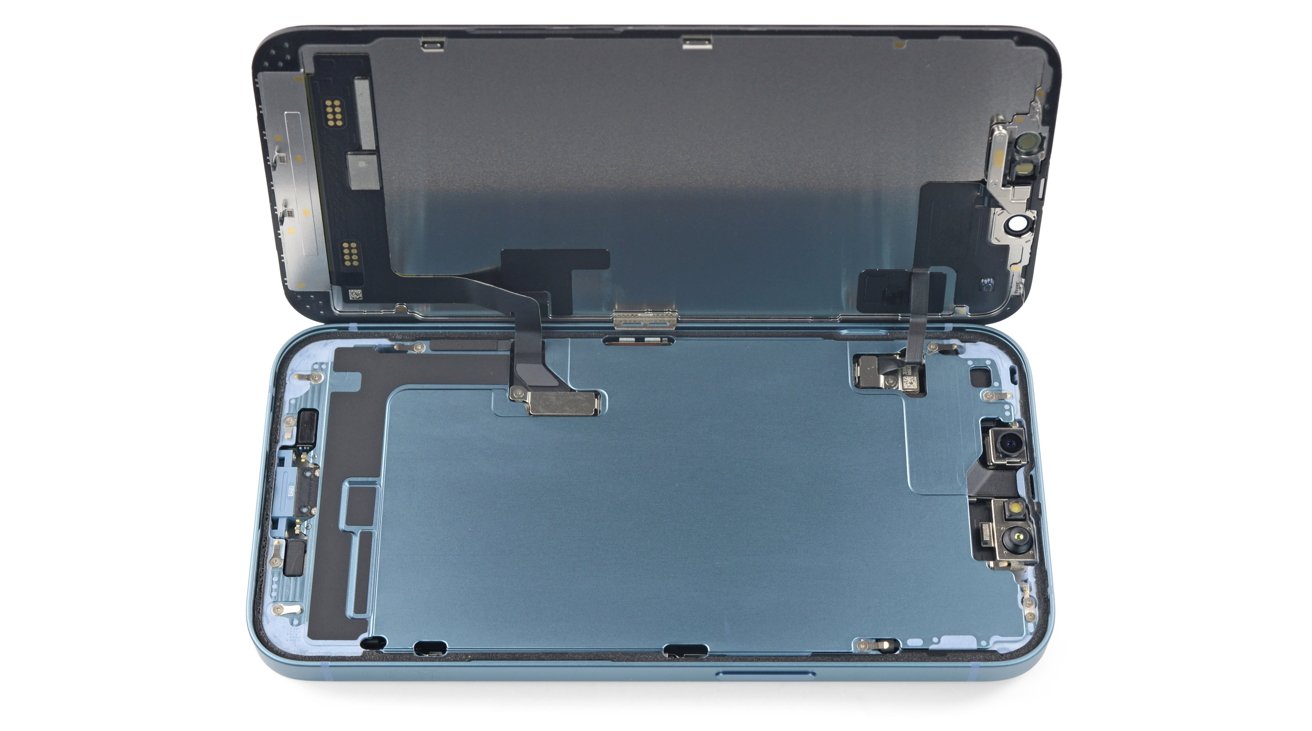The iPhone 14 is the most repairable iPhone in years
While the iPhone 14 features aren't hugely different from the iPhone 13, a teardown reveals Apple has made internal changes which make repairs easier.
Apple doesn't have the best reputation when it comes to enabling repairs. It has begrudgingly started to provide repair manuals and loans out tools to replace parts, but its products continue to be built in a way that can be considered difficult to fix.
In iFixit's customary teardown of the iPhone 14, the model has been found to be updated internally, including being able to be disassembled from the front and back. Usually, technicians have to remove the display to gain access to the internals for repairs, but now, the back glass can also be removed in a fairly similar way.
After applying heat and pulling the screen off carefully, the view of the inside of the iPhone 14 is blocked by a large metal panel, the midframe, with gaps to allow the camera and select connectors and components to poke through. It is reckoned that the design change should streamline screen repairs as well as protect components inside the iPhone that aren't usually protected by a metal plate.
Opening the rear glass follows a similar procedure, and again is believed to be a massive change on Apple's part. The back glass is the hardest element to remove from an iPhone normally, and costs users hundreds to replace outside of AppleCare+.
The decision is a big departure for Apple, as it previously allowed access via the display since it covers both display and battery replacements, two common repair tasks. By allowing the rear glass to be taken out for general rear access to components bar the display itself, Apple removes major hurdles for fixing the back glass, if it happens to be damaged.
For the rest of the teardown, screws can be removed to take out brackets and components, while two pull tabs and a little adhesive keep the battery in place. Other connectors can also be popped to disconnect components from each other.
Following the teardown, iFixit praised Apple's design changes, including how Apple fixed a challenge of maintaining strength and rigidity of the device, while still increasing access. Using a midframe helps absorb and shift around the shock from a drop, in a similar way to how the metal frame of an iPhone 13 would spread a shock to the battery and rear glass, except it is instead managed by a metal plate.
Separating the back panel also introduced a problem of RF transmissions, but instead of using welds, Apple used ten EMI contact points to ground the frame as much as possible.
However, the teardown isn't without criticism, with Apple being chided for requiring the back glass to be activated after activation.
For instance, the rear glass needs to be activated in software, the teardown video reveals. And, there are still software limits to prevent the use of aftermarket parts.
The substantial architecture change of the iPhone results in a repairability score of 7 out of 10, the highest for an iPhone since the iPhone 7 — which was released in 2016.
"This is the most substantial iPhone redesign since the X," writes iFixit. "It's hard to understate how big a change this is. For a reference point, Samsung hasn't changed their phone architecture since 2015."
 Malcolm Owen
Malcolm Owen
![The butterfly view of the iPhone 14, disassembled [via iFixit]](https://photos5.appleinsider.com/gallery/50453-99219-iPhone14_Pro-388-2_edit-squashed-edited-2048x1536-xl.jpg)
![Opening the iPhone 14 via the rear [via iFixit]](https://photos5.appleinsider.com/gallery/50453-99218-iPhone14-219_edit-edited-2048x1281-xl.jpg)














 Amber Neely
Amber Neely
 Thomas Sibilly
Thomas Sibilly
 AppleInsider Staff
AppleInsider Staff
 William Gallagher
William Gallagher

 Christine McKee
Christine McKee










12 Comments
Next thing that needs to change: Printer manufacturers need to drop the annoying messages when owners choose to use a third party inkjet cartridge. "You did not install a genuine cartridge." "This may damage your printer and invalidate your warranty." "Continue with current cartridge?" (With responses after each warning. Alternative, market cartridges without the outlandish markups.)
Maybe, if I'm lucky, when I'm due to replace my iPhone, I'll be able to replace the battery in that future model without any tools (or maybe a simple, common home tool). Like we could do with some of the old flip phones. Would like to see that on some future mac laptop as well. (But not holding my breath.)